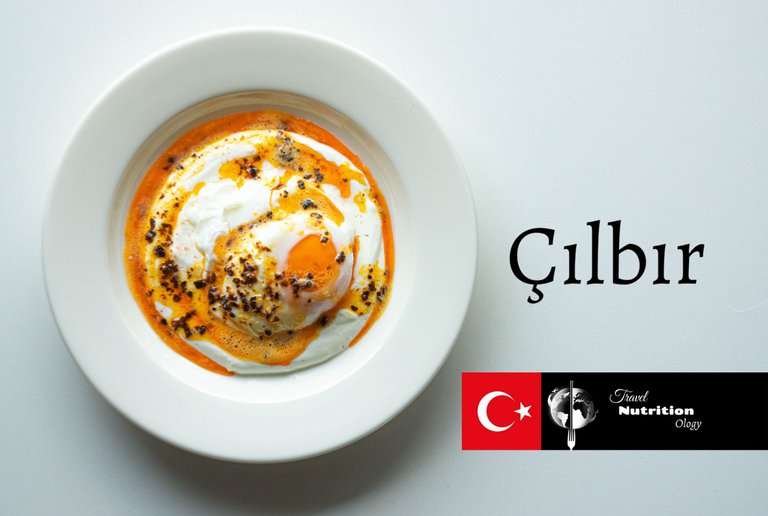Beginning our journey from Istanbul had granted me a good excuse to embark Tranutriology's foodie journey on a Turkish dish. An authentic, simple dish with a history rooted in the 15th century.
Çılbır (pronounced as "chl-br") is recorded to be eaten by Ottoman sultans. Some say it even was one of the dishes sultan Osman fancied the most - though I couldn't find any official reference to that specific detail. Howsoever, one fact remains that this appetizing egg dish has survived through centuries, and is still being served as a common breakfast dish. It may owe the fact to being plain but palatable, economic but perfectly resembling Turkish cuisine characteristics and most importantly, being extremely addictive.

[here's the dish I've made. It's photographed by my partner @a0i -Sigma 24mm f/1.8 macro lens, sony a77 camera]
Ingredients (per serving)
| Item | Quantity | |
|---|---|---|
| Fresh eggs (at most 2 days old) | 2 | |
| Vinegar | 1 tbs | |
| Turkish/greek yoghurt | 3 tbs | |
| Garlic | ½ clove | |
| Salt | ⅛ tsp | |
| Butter | 1.5 tbs | |
| Pulbiber | ¼ tsp |
Preparation
The dish consists of three components, the yoghurt sauce in the plate's base, topped with poached eggs, and a buttery dressing that is applied at the end of preparation. The process is quite simple, quick, and doesn't need specific cooking skills.
Yoghurt sauce
To prepare the sauce, you'll need some room-temperature yoghurt. Strained Turkish yoghurt - "süzme yoğurt" as Turks say- is the most recommendable option. However, if it's not available, you can use any type of yoghurt with the same consistency, such as Greek yoghurt.
Mix half of the clove of crushed garlic with a pinch of salt and three tablespoons of yoghurt. The finalized mixture should have custard consistency. You can also mix boiling water with cold yoghurt to increase the temperature and get the ideal texture.
Add the prepared sauce to your serving plate. Spread and flatten it to get a circular layer of the sauce as you can see in the picture.
Poached eggs
All you need for making perfect poached eggs are fresh eggs, a pan, some water and vinegar.
It's important to use fresh (at most 2 days old) eggs since the older an egg gets, the runnier the white will become. Too runny egg whites are easily disturbed by boiling water. So you'd either end up with detached parts of egg whites in the pan or some that are too spreaded.
To get a more decent and representable look, some people would go beyond freshness. They'd crack the egg in a sieve and get rid of the watery part before they'd boil the egg.
Nonetheless, that's something I'd never recommend. I rather get some less tidy looking poached eggs than waste food [in fact, I didn't do it for the photo either. It certainly is not the tidiest poached egg ever but it's not that bad right! ;) ]
Straightway back into the instructions, bring some water to a boil in a pan. Add a tablespoon of vinegar to the water (this will make the boiling process less severe and disturbing, meanwhile it won't affect the egg's taste at all).
Let the mixture boil on a low simmer, where there are only small bubbles.
Gently put the cracked eggs into the water (crack the eggs in a bowl or ladle first and then transport it to the pan). Let them boil from 2 to 3 minutes. (the ideal timing depends on egg size and its temperature. Generally cooking them for more than three minutes will harden the yolk which is not recommended. Unless you prefer it hard-boiled.)
Wait 30 seconds after adding each egg so the water temperature remains stable.
After the eggs are done, put them on top of the sauce on the serving plate.
The dressing
Add one and a half tablespoons of butter to a hot pan/pot. Let it melt and become golden brown (not burned, just a bit brownish, that's how Turks prefer it). Add one-fourth teaspoon of pulbiber to it. Let the spice be infused in butter for some 30 seconds. And then be prepared to dress the eggs with this sizzling hot goodness.
Feel free to elevate your taste buds' trip to Turkey by serving some Turkish tea and simit/poğaça (two types of Turkish bread) alongside the dish.
Pulbiber and its alternatives
Pulbiber (pul=flake, biber=pepper [Turkish]) is often made of a Turkish variant of pepper. It's not as hot as Cayenne pepper nor as mild as paprika, while the colouring effect is as strong as Gochugaru (a Korean variant of pepper).
Are there any substitutes for pulbiber?
Well yes, some recommend using Aleppo and paprika instead. I personally prefer a mixture of Cayenne and Paprika or just Gochugaru.
Do I recommend using alternatives?
Preferably not. Though not for the sake of Biber's fever! Just that I believe if you want to feel the exact taste of this traditional Turkish dish, Pulbiber is the only substance that can provide that flavour (just as I would say the same for using Gochugaru in certain Korean cuisines).